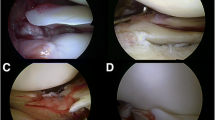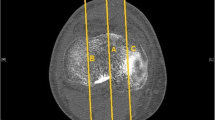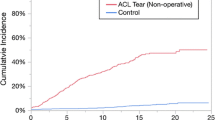Abstract
The purposes of this multi-center study were: (a) to document the location and type of meniscal and chondral lesions that accompany anterior cruciate ligament (ACL) tears, and (b) to test for possible relationships between these lesions and patient age, time from initial injury (TFI), and sports level (i.e., recreation, amateur, professional, and national). The cases of 764 patients with ACL tears who underwent arthroscopy for the first time were retrospectively analyzed. The group included 684 males and 80 females of mean age 27 years (range 14–59 years). The mean TFI was 19.8 months (range 0.2–360 months). Eighty-seven percent of the group engaged in regular sporting activity. Thirty-seven percent had medial meniscal tears, 16% had lateral meniscal tears, and 20% had tears of both menisci. The most common tear types were longitudinal tears in the posterior and middle horns of both menisci. Tears of the lateral meniscus were more centrally located than those of the medial meniscus. Incomplete tears and radial tears were significantly more common in the lateral meniscus. Nineteen percent of the knees had one or more chondral lesions. Sixty percent of the chondral lesions were located in the medial tibio-femoral compartment. Patient age was statistically associated with presence of a medial meniscal tear, presence of a grade 3 or 4 chondral lesion, and presence of a complex tear of the medial meniscus. Sports level was not statistically related to any of the parameters studied. The odds of having a medial meniscal tear at 2 to 5 years TFI were 2.2 times higher than the odds in the first year post-injury, and the odds at >5 years were 5.9 times higher than at 0 to 12 months TFI. The frequency of lateral meniscal tear remained fairly constant at 2 years TFI. The odds of having a grade 3 or 4 chondral lesion were 2.7 times greater at 2 to 5 years TFI than they were at 1 year post-injury, and these odds increased to 4.7 when patients at >5 years TFI were compared to those in the 2 to 5 years category. Multivariate analysis demonstrated that TFI and age were equally important predictors of lateral meniscal tears and of grade 3 or 4 chondral lesions; however, TFI was the better predictor of medial meniscal tear.




Similar content being viewed by others
References
Bonamo JJ, Fay C, Firestone T (1990) The conservative treatment of anterior cruciate deficient knee. Am J Sports Med 18:618–623
Cerabona F, Sherman MF, Bonamo JR, Sklar J (1988) Patterns of meniscal injury with acute anterior cruciate ligament tears. Am J Sports Med 16:603–609
Cipolla M, Scala A, Gianni E, Puddu G (1995) Different patterns of meniscal tears in acute anterior cruciate ligament (ACL) ruptures and in chronic ACL-deficient knees. Classification, staging and timing of treatment. Knee Surg Sports Traumatol Arthrosc 3:130–134
Cooper DE, Arnoczky SP, Warren RF (1990) Arthroscopic meniscal repair. Clin Sports Med 9:589–607
Daniel DM (1993) Selecting patients for ACL surgery. In: Jackson DW (ed) The anterior cruciate ligament. Current and future concepts. Raven Press, New York, pp 251–258
Fitzgibbons RE, Shelbourne KD (1995) Aggressive nontreatment of lateral meniscal tears seen during anterior cruciate ligament reconstruction. Am J Sports Med 23:156–159
Gillquist J, Messner K (1999) Anterior cruciate ligament reconstruction and the long-term incidence of gonarthrosis. Sports Med 27:143–156
International Cartilage Repair Society (1998) The Cartilage Standard Evaluation Form/Knee. ICRS Newsletter Spring 1998, p 7
Jager A, Braune C, Welsch F, Khoudeir S, Rauschmann MA (2002) Is meniscal repair an adequate procedure to prevent early osteoarthritis in athletes with chronic anterior knee instability? Zentralbl Chir 127:890–894
Javed A, Siddique M, Vaghela M, Hui AC (2002) Interobserver variations in intra-articular evaluation during arthroscopy of the knee. J Bone Joint Surg Br 84:48–49
Jomha NM, Borton DC, Clingeleffer AJ, Pinczewski LA (1999) Long-term osteoarthritic changes in anterior cruciate ligament reconstructed knees. Clin Orthop 358:188–193
Keene G, Bickerstaff D, Paterson R (1993) The natural history of meniscal tears in anterior cruciate insufficiency. Am J Sports Med 21:672–679
Larsen E, Jensen PK, Jensen PR (1999) Long-term outcome of knee and ankle injuries in elite football. Scand J Med Sci Sports 9:285–289
McDaniel WJ, Dameron TB (1983) The untreated anterior cruciate ligament rupture. Clin Orthop 172:158–163
Murrell GAC, Maddali S, Horovitz L, Oakley SP, Warren RF (2001) The effects of time course after anterior cruciate ligament injury in correlation with meniscal and cartilage loss. Am J Sports Med 29:9–14
Nikolic DK (1998) Lateral meniscal tears and their evolution in acute injuries of the anterior cruciate ligament of the knee. Arthroscopic analysis. Knee Surg Sports Traumatol Arthrosc 6:26–30
Paletta GA, Levine DS, O'Brien SJ, Wickiewicz TL, Warren RF (1992) Patterns of meniscal injury associated with acute anterior cruciate ligament injury in skiers. Am J Sports Med 20:542–547
Roos H, Lindberg H, Gardsell P, Lohmander LS, Wingstrand H (1994) The prevalence of gonarthrosis and its relation to meniscectomy in former soccer players. Am J Sports Med 22:219–222
Roos H, Adalberth T, Dahlberg L, Lohmander LS (1995) Osteoarthritis of the knee after injury to the anterior cruciate ligament or meniscus: the influence of time and age. Osteoarthritis Cartilage 3:261–267
Segawa H, Omori G, Koga Y (2001) Long-term results of non-operative treatment of anterior cruciate ligament injury. Knee 8:5–11
Smith JP 3rd, Barrett GR (2001) Medial and lateral meniscal tear patterns in anterior cruciate ligament-deficient knees. A prospective analysis of 575 tears. Am J Sports Med 29:415–419
Van Kampen A, Waal-Malefijit MC, Jersoch J, Castro WMH, Busch M, Pape M (1998) Interobserver variance in diagnostic arthroscopy of the knee. Knee Surg Sports Traumatol Arthrosc 6:16–20
Acknowledgement
The authors wish to thank Associate Professor Seval Akgün, Department of Public Health, Başkent University for her invaluable assistance with the statistical analysis.
Author information
Authors and Affiliations
Corresponding author
Additional information
This multi-center study was performed by the Turkish Society of Sports Traumatology, Arthroscopy and Knee Surgery. It was presented as a poster at the ESSKA 2000 Congress in London, UK
Rights and permissions
About this article
Cite this article
Tandogan, R.N., Taşer, Ö., Kayaalp, A. et al. Analysis of meniscal and chondral lesions accompanying anterior cruciate ligament tears: relationship with age, time from injury, and level of sport. Knee Surg Sports Traumatol Arthrosc 12, 262–270 (2004). https://doi.org/10.1007/s00167-003-0398-z
Received:
Accepted:
Published:
Issue Date:
DOI: https://doi.org/10.1007/s00167-003-0398-z




